Hox genes Study guides, Class notes & Summaries
Looking for the best study guides, study notes and summaries about Hox genes? On this page you'll find 98 study documents about Hox genes.
Page 2 out of 98 results
Sort by
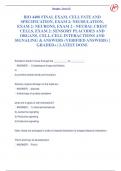
-
BIO 4400 FINAL EXAM, CELL FATE AND SPECIFICATION, EXAM 2: NEURULATION, EXAM 2: NEURONS, EXAM 2 - NEURAL CREST CELLS, EXAM 2: SENSORY PLACODES AND ORGANS, CELL-CELL INTERACTIONS AND SIGNALING & ANSWERS (VERIFIED ANSWERS) | GRADED+ | LATEST DONE
- Exam (elaborations) • 159 pages • 2024
-
- $12.89
- + learn more
Ectoderm doesn't move through the __________ or __________ ANSWER: 1) blastopore (frogs and fishes) or 2) primitive streak (birds and humans) Sensory organs all begin in the head as... ANSWER: placode - thickenings of surface ectoderm what are 4 types of cell interactions? ANSWER: 1) Internal/mechanical 2) Juxtacrine signaling 3) Paracrine signaling 4) Endocrine signaling Note: these are arranged in order of closest interaction to longest distance interaction The 6 word key to ...
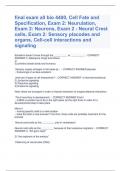
-
final exam all bio 4400, Cell Fate and Specification, Exam 2: Neurulation, Exam 2: Neurons, Exam 2 - Neural Crest cells, Exam 2: Sensory placodes and organs, Cell-cell interactions and signaling
- Exam (elaborations) • 95 pages • 2024
-
- $30.49
- + learn more
final exam all bio 4400, Cell Fate and Specification, Exam 2: Neurulation, Exam 2: Neurons, Exam 2 - Neural Crest cells, Exam 2: Sensory placodes and organs, Cell-cell interactions and signaling Ectoderm doesn't move through the __________ or __________ - CORRECT ANSWER 1) blastopore (frogs and fishes) or 2) primitive streak (birds and humans) Sensory organs all begin in the head as... - CORRECT ANSWER placode - thickenings of surface ectoderm what are 4 types of cell interact...
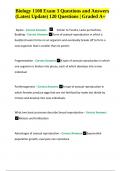
-
Biology 1108 Exam 3 Questions and Answers (Latest Update) 120 Questions | Graded A+
- Exam (elaborations) • 21 pages • 2023
-
- $15.49
- + learn more
Biology 1108 Exam 3 Questions and Answers (Latest Update) 120 Questions | Graded A+. Alpine - Correct Answers Similar to Tundra, Lacks permafrost, Budding - Correct Answers Form of asexual reproduction in which a bud/protrusion forms on an organism and eventually breaks off to form a new organism that is smaller than its parent. Fragmentation - Correct Answers A type of asexual reproduction in which one organism is broken into pieces, each of which develops into a new individual Partheno...
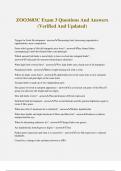
-
ZOO3603C Exam 3 Questions And Answers (Verified And Updated)
- Exam (elaborations) • 5 pages • 2024
- Available in package deal
-
- $10.49
- + learn more
ZOO3603C Exam 3 Questions And Answers (Verified And Updated) Trigger for Limb Development - answerDecreasing food, decreasing reproductive opportunities, more competition From which group of fish did tetrapods arise from? - answerRay-finned fishes (actinopterygii) and lobe-finned fishes (sarcopterygii) Which ancient fish limbs is more likely to have evolved into tetrapod limbs? - answerCoelacanth fin strucutre (homologous elements) What digit limb evolved first? - answerFive digit limbs ...
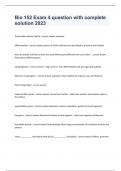
-
Bio 152 Exam 4 question with complete solution 2023
- Exam (elaborations) • 10 pages • 2023
- Available in package deal
-
- $9.99
- + learn more
Bio 152 Exam 4 question with complete solution 2023Transcription factors bind to - correct answer promoter Differentiation - correct answer process in which cells become specialized in structure and function How do somatic cells that all have the same DNA become different from each other? - correct answer They express different genes morphogenesis - correct answer "origin of form" how differentiated cells get organized spatially What are morphogens? - correct answer substances that...
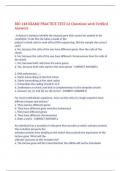
-
BIO 148 EXAM2 PRACTICE TEST 63 Questions with Verified Answers,100% CORRECT
- Exam (elaborations) • 11 pages • 2024
-
- $10.99
- + learn more
BIO 148 EXAM2 PRACTICE TEST 63 Questions with Verified Answers . A doctor is trying to identify the mutant gene that causes her patient to be colorblind. To do this she takes a swab of the patient's cheek cells to send off for DNA sequencing. Did she sample the correct cells? a. No, because the cells of the eye have different genes than the cells of the cheek. b. No, because the cells of the eye have different chromosomes than the cells of the cheek. c. Yes, because both cells have the s...
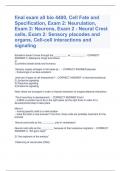
-
final exam all bio 4400, Cell Fate and Specification, Exam 2: Neurulation, Exam 2: Neurons, Exam 2 - Neural Crest cells, Exam 2: Sensory placodes and organs, Cell-cell interactions and signaling
- Exam (elaborations) • 95 pages • 2024
-
- $20.49
- + learn more
final exam all bio 4400, Cell Fate and Specification, Exam 2: Neurulation, Exam 2: Neurons, Exam 2 - Neural Crest cells, Exam 2: Sensory placodes and organs, Cell-cell interactions and signaling Ectoderm doesn't move through the __________ or __________ - CORRECT ANSWER 1) blastopore (frogs and fishes) or 2) primitive streak (birds and humans) Sensory organs all begin in the head as... - CORRECT ANSWER placode - thickenings of surface ectoderm what are 4 types of cell interact...
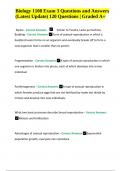
-
Biology 1108 Exam 3 Questions and Answers Latest Update | 120 Questions | Graded A+
- Exam (elaborations) • 21 pages • 2023
-
- $16.49
- + learn more
Biology 1108 Exam 3 Questions and Answers (Latest Update) 120 Questions | Graded A+. Alpine - Correct Answers Similar to Tundra, Lacks permafrost, Budding - Correct Answers Form of asexual reproduction in which a bud/protrusion forms on an organism and eventually breaks off to form a new organism that is smaller than its parent. Fragmentation - Correct Answers A type of asexual reproduction in which one organism is broken into pieces, each of which develops into a new individual Partheno...
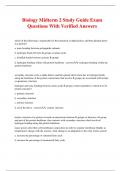
-
Biology Midterm 2 Study Guide Exam Questions With Verified Answers
- Exam (elaborations) • 28 pages • 2024
- Available in package deal
-
- $13.49
- + learn more
Biology Midterm 2 Study Guide Exam Questions With Verified Answers which of the following is responsible for the formation of alpha-helices and beta-pleated sheets in a protein? a. ionic bonding between polypeptide subunits b. hydrogen bonds between R-groups of amino acids c. disulfide bonds between cysteine R-groups d. hydrogen bonding within with protein backbone - answerd. hydrogen bonding within the protein backbone secondary structure such as alpha helices and beta-plated sheets fo...
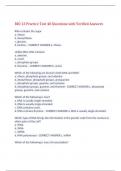
-
BIO 13 Practice Test 40 Questions with Verified Answers,100% CORRECT
- Exam (elaborations) • 8 pages • 2024
-
- $10.79
- + learn more
BIO 13 Practice Test 40 Questions with Verified Answers RNA contains the sugar a. ribose. b. deoxyribose. c. glucose. d. lactose. - CORRECT ANSWER a. ribose. Unlike DNA, RNA contains a. adenine. b. uracil. c. phosphate groups. d. thymine. - CORRECT ANSWER b. uracil. Which of the following are found in both DNA and RNA? a. ribose, phosphate groups, and adenine b. deoxyribose, phosphate groups, and guanine c. phosphate groups, guanine, and cytosine d. phosphate grou...



